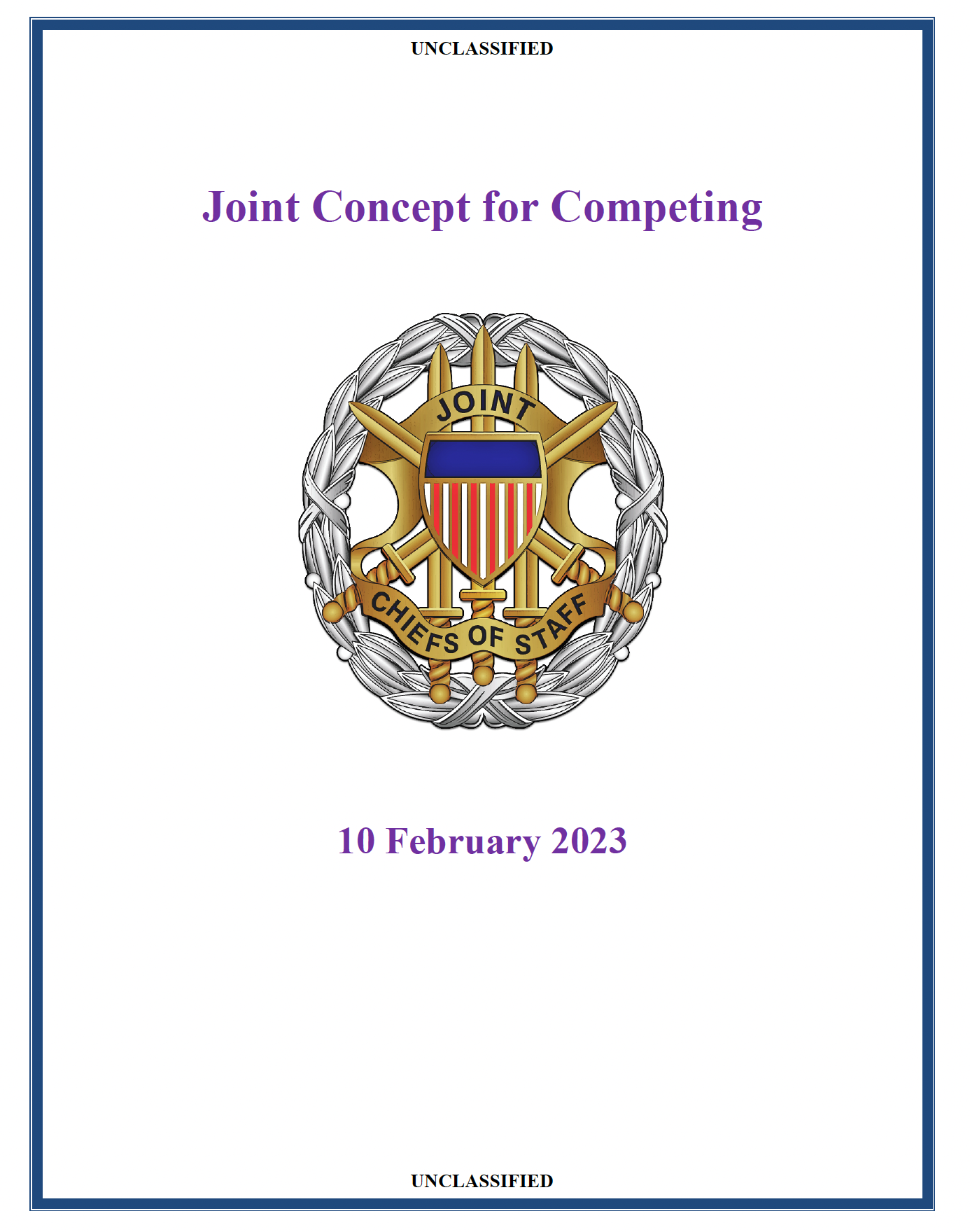Joint Concept For Competing
This unclassified 91 page document was recently published.
It can be downloaded HERE.
Page 1 of the EXSUM is below.
Some key points:
Strategic competition is a persistent and long-term struggle that occurs between two or more adversaries seeking to pursue incompatible interests without necessarily engaging in armed conflict with each other.
…
We think of being at peace or war…our adversaries don’t think that way.
…
Strategic competition is thus an enduring condition to be managed, not a problem to be solved.
…
By taking actions designed to shift the focus of strategic competition into areas that favor U.S. interests or undermine an adversary’s interests, the Joint Force can exploit the competitive space to gain advantage over adversaries and pursue national interests.
…
The United States can and should develop a more holistic approach to strategic competition that recognizes and seizes upon the irregular, non-lethal, and non-military aspects of competing as fundamental to success, and that focuses on U.S. interests and values, not just what it opposes.
…
The Joint Force will conduct irregular warfare operations and activities proactively to subvert, create dilemmas for adversaries, and impose costs on an adversary’s strategic interests, including its economy, civil society, institutional processes, and critical infrastructure. Irregular warfare favors indirect and asymmetric approaches, though it may employ the full range of military and other capabilities, in order to erode an adversary’s power, influence, and political will.”
It also recognizes the importance of understanding China’s Unrestricted Warfare:
China, in particular, has rapidly become more assertive; it is the only competitor capable of mounting a sustained challenge to a stable and open international system.17 In 1999, Chinese People’s Liberation Army (PLA) Colonels Qiao Liang and Wang Xiangsui wrote the “new principles of war are…using all means, including armed force or non-armed force, military and non-military, and lethal and non-lethal means to compel the enemy to accept one’s interests.” Accordingly, the People’s Republic of China (PRC) does not seek to defeat the United States in a direct military confrontation. The PRC intends to deter U.S. intervention militarily and present the United States with a fait accompli that compels the United States to accept a strategic outcome that results in a PRC regional sphere of influence and an international system more favorable to PRC national interests and authoritarian preferences.
It appears that the JCS doctrine still embraces Department of Defense Irregular Warfare Annex to the National Defense Strategy. 2019. It is referenced a number of times along with the Joint Chiefs of Staff Irregular Warfare Mission Analysis, 19 October 2021.
I notice a number of parallels between this JCC and USASOC’s White Paper on Support to Political Warfare from 2015. I recommend reading it in conjunction with the JCC. The white paper can be accessed HERE.

EXECUTIVE SUMMARY
Based on combatant commander (CCDR) assessments of their limited ability to compete
successfully in strategic competition, at a Joint Chiefs of Staff (JCS) Tank on 19 June 2020, the
Chairman of the Joint Chiefs of Staff (CJCS) directed the development of a joint concept for
competition to drive joint strategic planning and joint force development and design. The Joint
Concept for Competing (JCC) advances an intellectual paradigm shift to enable the Joint Force,
in conjunction with interagency, multinational, and other interorganizational partners, to engage
successfully in strategic competition. For the purposes of this concept, strategic competition is
a persistent and long-term struggle that occurs between two or more adversaries seeking to
pursue incompatible interests without necessarily engaging in armed conflict with each
other. The normal and peaceful competition among allies, strategic partners, and other
international actors who are not potentially hostile is outside the scope of this concept.
The Strategic Environment
Recognizing the overwhelming conventional military capability demonstrated during Operation
DESERT STORM in 1991 and Operation IRAQI FREEDOM in 2003, U.S. adversaries
responded by seeking to circumvent U.S. deterrent posture through competitive activity below
the threshold of armed conflict with the United States. Adversaries are employing cohesive
combinations of military and civil power to expand the competitive space. Adversaries aim to
achieve their strategic objectives through a myriad of ways and means, including statecraft and
economic power as well as subversion, coercion, disinformation, and deception. They are
investing in key technologies designed to offset U.S. strategic and conventional military
capabilities (e.g., nuclear weapons, anti-access and area denial systems, offensive cyberspace,
artificial intelligence, hypersonic delivery systems, electromagnetic spectrum). Simply put, our
adversaries intend to “win without fighting,” but they are also building military forces that
strengthen their ability to “fight and win” an armed conflict against the United States. Facing
this dilemma, more of the same is not enough. By ignoring the threat of strategic competition,
and failing to compete deliberately and proactively, the United States risks ceding strategic
influence, advantage, and leverage while preparing for a war that may never occur. The United
States must remain fully prepared and poised for war, but this alone is insufficient to secure U.S.
strategic interests. If the Joint Force does not change its approach to strategic competition, there
is a significant risk that the United States will “lose without fighting.”
Purpose of Strategic Competition
Analyzing any adversary’s way of war is instructive. As former CJCS General Joseph F.
Dunford recognized, “We think of being at peace or war…our adversaries don’t think that
way.” They believe they are in a long-term “conflict without combat” to alter the current
international system, advance their national interests, gain strategic advantage and influence, and
limit U.S. and allied options. The JCC postulates that the Joint Force should also view the
spectrum of conflict as an enduring struggle between international actors with incompatible
strategic interests and objectives, but who also cooperate when their interests coincide.
Strategic competition is thus an enduring condition to be managed, not a problem to be
solved.




